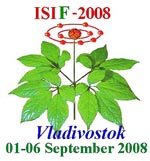

Scientific Program of "ISIF-2008"
The scientific program will be settled by the Scientific Advisory Board, in connection
with ISIF-2008 International Organizing Committee. Contributions on all
aspects of inorganic fluorine chemistry and technology will be welcome.
The ISIF-2008 will work in a seminar format and 14 key-note lectures, 36
oral and 58 poster presentations.
- General state of a natural fluorine raw material sources and new approaches to operation of raw deposits of inorganic fluorine.
Nowadays state of the traditional natural sources of fluorine and
environment at exploration of deposits. Secondary (technogenic) and new
probable operational resources of fluorine. Paths of risks decrease for
production of global warming potential gases by use of inorganic
fluoride technologies for improve of comfort life both present and
future generations.
- New theoretical approaches to the description electronic and molecular structure of inorganic fluorides.
Quantum chemical calculations of real fluoride structures in their
condensed state, including nanostructures and superstructures.
Coexistence of fluorine and oxygen in the crystalline and
nanocrystalline objects. New advanced methods of calculations for
thermodynamic and kinetic aspects of reaction abilities and
spectrochemical properties of inorganic fluorides.
- New pathways of some specific inorganic fluoride syntheses, including objects in their nanosized state.
The new theoretical approaches to the description of processes of
synthesis of some specific inorganic fluorides. F-organomentallic
precursors, spray-engineering, low-temperature synthesis, hydrothermal
synthesis, photosynthesis, propagation of chips etc. The nanosized
powders and films, single nanocrystals, nanocomposites on the base of
inorganic, organic and polymeric fluoride materials. Open structures -
zeolites, mesophases on the ground of inorganic fluorides.
- Last reaches of structural, physical and analytical chemistry of inorganic fluorides, including coordination compounds.
Problems of the description of correlation among theoretical structures
and substantial properties. New generalizations in chemistries of the
highest, lowest and unusual oxidation states of inorganic fluorides.
Clustering fluorides, clathrating fluorides, supramolecular and
permolecular F-compounds. Problems and new advanced solutions in
analytical chemistry of fluorine and fluorides.
- The bridges between inorganic, organic fluorides and catalysis.
Fluorous chemistry. Application of inorganic fluorides for replacement
of CFCs onto HFC at fluorination of organic molecules, in the chemistry
of perfluorinated organic solvents, in catalysis, sorption technologies
etc. Problems of catalytic reforming and utilisation of CFCs.
Possibilities of biomedical application of inorganic fluorides and
aggregates on their base.
- Application of fluorination at creations of covers on surfaces.
Fluorination in a gaseous fluid and in F-contained plasma medium.
Modification of surfaces of the materials (metals, ceramics, polymers,
elastomers). Technical applications in antifriction and hydrophobic
materials, in textile and woollen tissues, architecture etc.
- Role of inorganic fluorides in the chemical energetics and electrical engineering.
Lithium chemical electrical cells, including lithium-ionic systems.
Fuel cells. Various fluorinated carbon materials - graphites, diamonds,
nanotubes, fullerenes. Superionics, supercapacitors, actuators, and
hybrid microassembly.
- Applications of inorganic fluorides in optoelectronics and semiconductor industry.
Luminescent fluorides, glasses and ceramics, transducers of frequency,
use in an optical and ultra-violet range, including for laser
microlytography and printer technologies.
- Industrial production and perspective appendices of inorganic fluorides. New technologies for effective ecologically safe production of fluorine, fluorine hydride, new fluorating agents and other inorganic fluorides, including for nuclear, laser and electronic engineering etc. Recent trends and explorations of application of inorganic fluorides in metallurgy of lithium, aluminium, magnesium, titanium, and also in heavy non-ferrous metals.
Webmaster Arseny Slobodyuk, ampy(a)ich.dvo.ru, You are the 3147'th visitor of this site.
 scientific program
scientific program
topics
